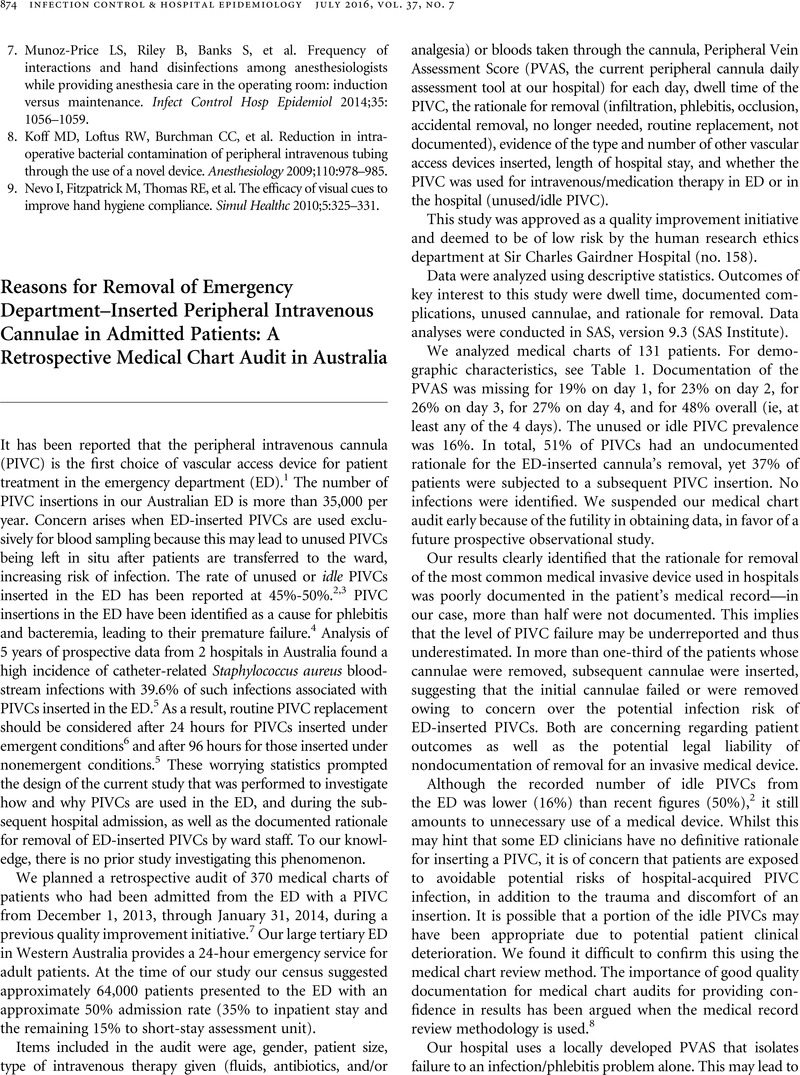Crossref Citations
This article has been cited by the following publications. This list is generated based on data provided by Crossref.
Carr, Peter J.
Higgins, Niall S.
Cooke, Marie L.
Rippey, James
and
Rickard, Claire M.
2017.
Tools, Clinical Prediction Rules, and Algorithms for the Insertion of Peripheral Intravenous Catheters in Adult Hospitalized Patients: A Systematic Scoping Review of Literature.
Journal of Hospital Medicine,
Vol. 12,
Issue. 10,
p.
851.
O'Connor, Kathleen
Lee, Andie
and
Fong, Gloria
2018.
A Case Series of Patients Developing Thrombophlebitis after Administration of Flucloxacillin via a Peripheral Intravenous Catheter.
Journal of the Association for Vascular Access,
Vol. 23,
Issue. 2,
p.
102.
Carr, Peter J.
Rippey, James C.R.
Cooke, Marie L.
Higgins, Niall S.
Trevenen, Michelle
Foale, Aileen
and
Rickard, Claire M.
2018.
From insertion to removal: A multicenter survival analysis of an admitted cohort with peripheral intravenous catheters inserted in the emergency department.
Infection Control & Hospital Epidemiology,
Vol. 39,
Issue. 10,
p.
1216.
Simin, Dragana
Milutinović, Dragana
Turkulov, Vesna
and
Brkić, Snežana
2019.
Incidence, severity and risk factors of peripheral intravenous cannula‐induced complications: An observational prospective study.
Journal of Clinical Nursing,
Vol. 28,
Issue. 9-10,
p.
1585.
Nickel, Barb
2020.
Hiding in Plain Sight: Peripheral Intravenous Catheter Infections.
Critical Care Nurse,
Vol. 40,
Issue. 5,
p.
57.
Davies, Hugh
Coventry, Linda L.
Jacob, Alycia
Stoneman, Laurita
and
Jacob, Elisabeth
2020.
Blood sampling through peripheral intravenous cannulas: A look at current practice in Australia.
Collegian,
Vol. 27,
Issue. 2,
p.
219.
Jacob, Elisabeth
Jacob, Alycia
Davies, Hugh
Jacob, Darren
Jenkins, Mark
Husain, Margaret
and
Coventry, Linda
2021.
The impact of blood sampling technique, including the use of peripheral intravenous cannula, on haemolysis rates: A cohort study.
Journal of Clinical Nursing,
Vol. 30,
Issue. 13-14,
p.
1916.
Pittiruti, Mauro
Van Boxtel, Ton
Scoppettuolo, Giancarlo
Carr, Peter
Konstantinou, Evangelos
Ortiz Miluy, Gloria
Lamperti, Massimo
Goossens, Godelieve Alice
Simcock, Liz
Dupont, Christian
Inwood, Sheila
Bertoglio, Sergio
Nicholson, Jackie
Pinelli, Fulvio
and
Pepe, Gilda
2023.
European recommendations on the proper indication and use of peripheral venous access devices (the ERPIUP consensus): A WoCoVA project.
The Journal of Vascular Access,
Vol. 24,
Issue. 1,
p.
165.





